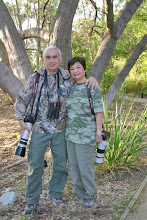Simply put, just like Leonardo da Vinci's famous painting, there were no eyebrows!
Two days ago we were at the La Mesa Ecopark to look for the Eyebrowed Thrush (a would be lifer). We dipped. Encouraged by our friend, Sean Melendres' report that he saw that particular species sometime after we left, we came back today with renewed hope. But dipped again.
It was not a total loss though. I got almost full frame shots of the Ashy Thrush - you know, the one without the eyebrow - feeding on the red fruits of the MacArthur palm tree.
Even better, my wife and I and birder friend, Irene Dy, were able to get really good shots of the endemic (and very curious) Guaiabero.
So at the end of the day, even without the eyebrows we still managed to get some smiles - just like Mona Lisa.
Seagull Recovery: A Time to Laugh
3 days ago

































